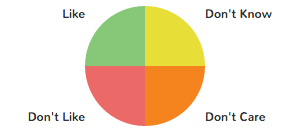Social media is centered around people’s opinions: presenting them, reading about them, quantifying them on large scales.
A University of Virginia family, too, is focused on people’s opinions online.
Jake Promisel, a rising third-year astronomy and physics major; his brother Mike, a 2014 alumnus in government; and their father, Andy, a 1985 U.Va. systems engineering graduate, founded GYRO, a new social media platform that allows users to express their opinions about Web content in an intuitive and accurate way, as well as see what other people think about the same content.
As explained in this promotional video, GYRO is centered around a rating system for Web content that is based on a four-color icon. Users click one part of the icon – green for “like,” yellow for “don’t know,” orange for “don’t care,” and red for “don’t like” – based on how they feel about the content. Users choose a rating and the GYRO icon automatically updates to represent the distribution of opinions about the specific piece of Web content.
Jake said that GYRO was designed to supplement the typically limited set of options – thumbs up, thumbs down – that social media users have to express their opinions.
“We want to make something that people can [use to] express their feelings with more variety than they can currently,” he said.
Prospective GYRO users must create an account on www.gyrosphere.net, a home page for their service and “community” where they can view detailed analytics about each piece of content they rate, including the distribution of opinion divided up by gender, age and other factors.
“We think the color rating system is not only intuitive, but also can show powerful insights about our society,” Jake said.
The Promisel brothers said that the original idea for GYRO originated from their father, who came up with the basic premise of the service after Mike and Jake first started using social media. Andy said he was frustrated by some aspects of social sites and wanted to come up with a way to easily express a range of opinions and eventually control with more precision what sort of content users see on social media.
The Promisels agree, however, that once Andy came up with the basic concept, GYRO became a collaborative venture.
“Jake and Mike helped refine my overall concept, prioritize the key features and functions, establish the look and feel, and target GYRO more toward their peers – one of our key demographics,” Andy said.
The brothers tested the idea at the 2013 U.Va. Entrepreneurial Cup. Mike and Jake (then fourth- and first-years, respectively), along with their father as an alumni participant, fleshed out the idea, entered the competition and presented the idea. Though they were not among the winners, “that really gave us a lot of momentum,” Mike said.
The Promisels then made a marketing video explaining GYRO that they use to promote the service. Late last summer, the Promisels began working with Gigantic Microphone, a software development company owned by Andy’s cousin, Sidney Lindner, to start designing the product.
The Promisels entered Charlottesville’s Galant Challenge in April, a showcase at the Tom Tom Founders Festival in which entrepreneurs compete for more than $500,000 in investments, which led to another U.Va. alumnus signing on as an adviser, Jake said.
Despite the fact that GYRO is a serious business venture, the Promisels also regard GYRO more as a family project, which Jake said means that when they are spending time on it, they are doing so because they are truly motivated to do so. He also said that working as a family, and the comfort level that comes with that, has been instrumental over the course of the product’s development.
“We’re honest with each other,” he said. “I think that’s helped us refine our vision a little bit better.”
The company recently released a GYRO widget that can be embedded in any webpage, alongside any piece of content. Jake said that their current focus is “getting the widget out there” and getting exposure for the service.
You can see the widget in action at collegestartup.org, and try out their service at www.gyrosphere.net.
Media Contact
Article Information
August 11, 2015
/content/social-media-startup-gyro-lets-users-do-more

